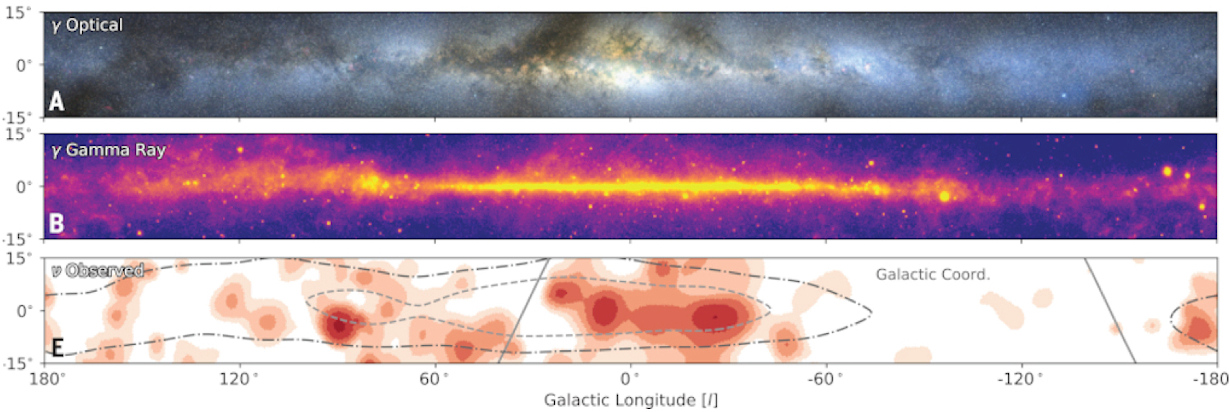in
High Energy Astrophysics Picture Of the Week

 Credit: IceCube collaboration (adapted from Science Vol. 380, pg. 1338)
Credit: IceCube collaboration (adapted from Science Vol. 380, pg. 1338)
Ghosts of the Milky Way
Visible light is the most common messenger which brings us information about the goings-on in our Galaxy. Visible light actually represents only a tiny fraction of the information available over the entire electromagnetic spectrum. High-energy gamma ray emission also arises from extreme, powerful cosmic explosions like supernovae and other extreme processes. But extreme phenomena in the Milky Way are revealed not only by electromagnetic radiation. High-energy charged particles called cosmic rays fly throughout the Galaxy at nearly the speed of light. Frustratingly, though, the direction that these charged particles travel gets scrambled by the Milky Way's magnetic field so it's nearly impossible to tell what extraordinary event produced them, or where they come from. But neutrinos, those mysterious "ghost particles" are produced by the some of the same processes that generate cosmic rays. Neutrinos, however, have no electric charge, and so are unaffected by the Galaxy's magnetic field, meaning that they can be used to pinpoint the particle accelerators producing cosmic rays. Unfortunately, though, neutrinos rarely interact with normal matter, and so are extremely difficult to detect - in fact trillions of neutrinos pass transparently through your body every second without you even knowing. The most advanced neutrino telescope on earth is the IceCube observatory in Antarctica. IceCube consists of more than 5,000 light sensitive detectors suspended within a cubic kilometer of the clear, pure, and stable Antarctic ice sheet. Rare interactions between cosmic neutrinos and the water nuclei in this enormous volume of ice produce faint flashes of light which can be detected by IceCube's detector modules. Now, for the first time, IceCube has seen the ghostly glow of faint neutrino emission from sources within our own Milky Way. The image above shows multi-wavelength views of the Milky Way in visible light (top) and in high-energy gamma rays (from the Fermi Gamma-ray Space Telescope, middle). The images are in Galactic coordinates, with the center of the Galaxy at the center of each map, and the flattened spiral disk of the Milky Way stretching along the center of the image from left to right. In visible light, the disk is dominated by bright emission from stars and gas clouds and dark bands due to dust. Bright gamma ray emission is produced by strange objects like neutron stars and black holes, and by interactions between interstellar matter and cosmic rays. The IceCube study, using a sophisticated new analysis of 60,000 neutrinos detected by IceCube in 10 years of data, shows that strange sources near the Galactic center produce neutrinos, and that the neutrino emission is consistent with the neutrinos expected from interactions of cosmic rays and interstellar matter within the Galaxy.
Published: July 10, 2023
<
HEA Dictionary ● Archive
● Search HEAPOW
● Other Languages
● HEAPOW on Facebook
● Download all Images
● Education ● HEAD
>

Each week the HEASARC
brings you new, exciting and beautiful images from X-ray and Gamma ray
astronomy. Check back each week and be sure to check out the HEAPOW archive!
Page Author: Dr. Michael F. Corcoran
Last modified Tuesday, 27-Feb-2024 10:06:47 EST


